Pepijn Lijnders has made a name for himself as one of the most innovative minds in modern football, and his work with RB Salzburg is a perfect example of that. Known for their high-intensity pressing and fluid attacking play, RB Salzburg under Lijnders showcases a blend of tactical intelligence and relentless energy. The former assistant of Jürgen Klopp has created a playing style highly influenced by his old mentor while incorporating his own unique ideas. This article delves into the key strategies and principles behind the team’s success, exploring how Lijnders’ tactical approach has shaped their dynamic style of play on both ends of the pitch.
Build-up
Low Build-up
Pep Lijnders sets his team up in a 1-4-2-2-2 formation in the low build-up. He uses two dropping strikers/number-tens and looks to attract opposition players to open up the space in behind for the wingers to exploit.
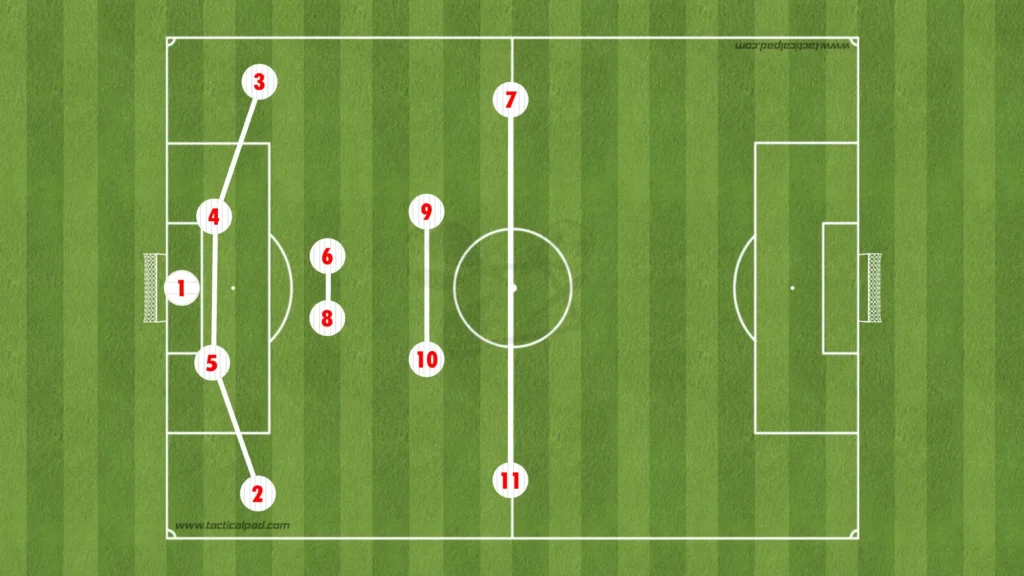
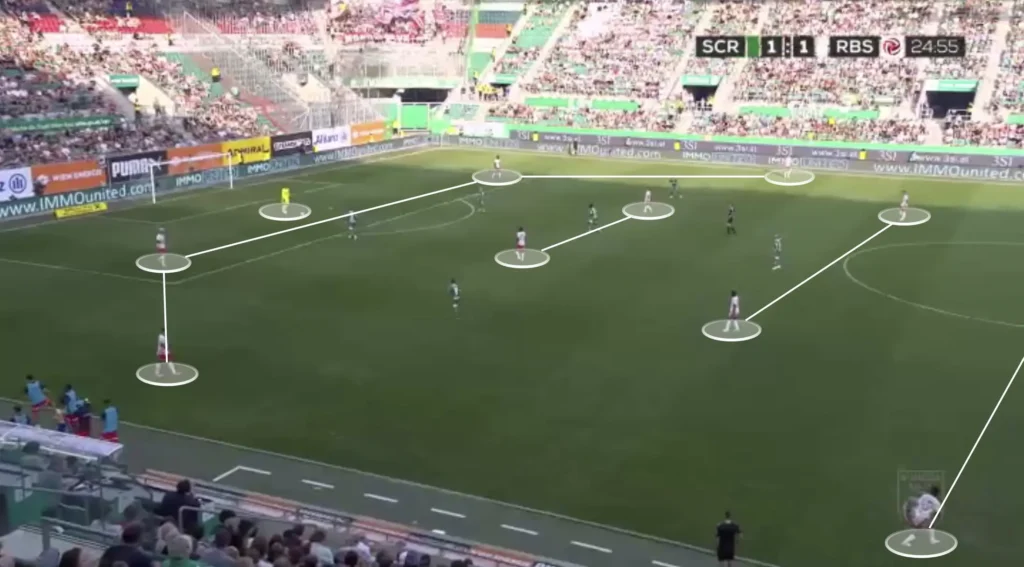
This structure with two dropping strikers and two high wingers, popularized by Roberto De Zerbi, questions the opposition center-backs, forcing them to make difficult decisions. If they push up on the dropping strikers, the space behind them opens up, giving the winger a 1v1 against the fullback in a massive space.
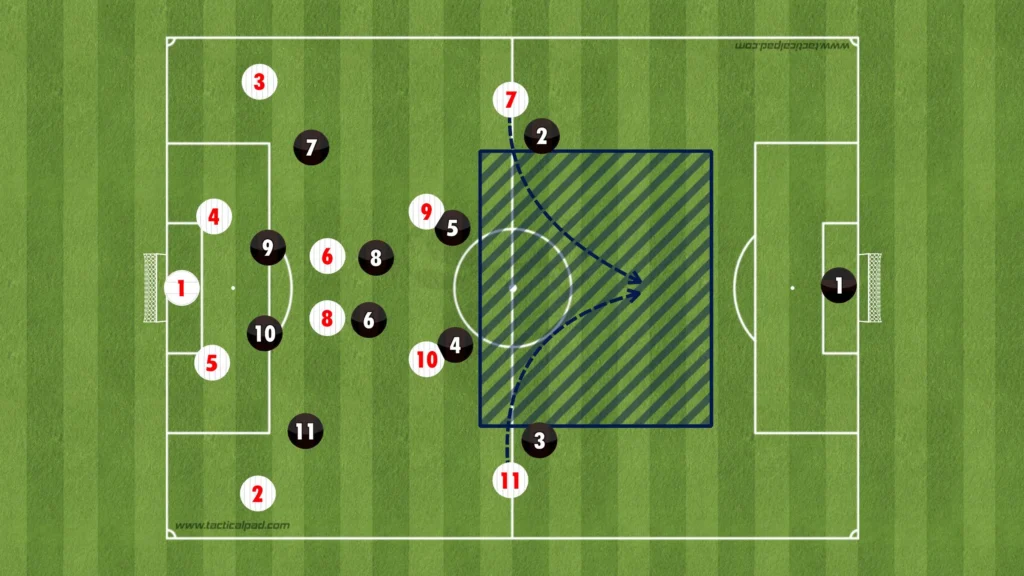
However, if they do not push up on the strikers, a numerical superiority is created in the midfield, allowing Salzburg to play through the press.
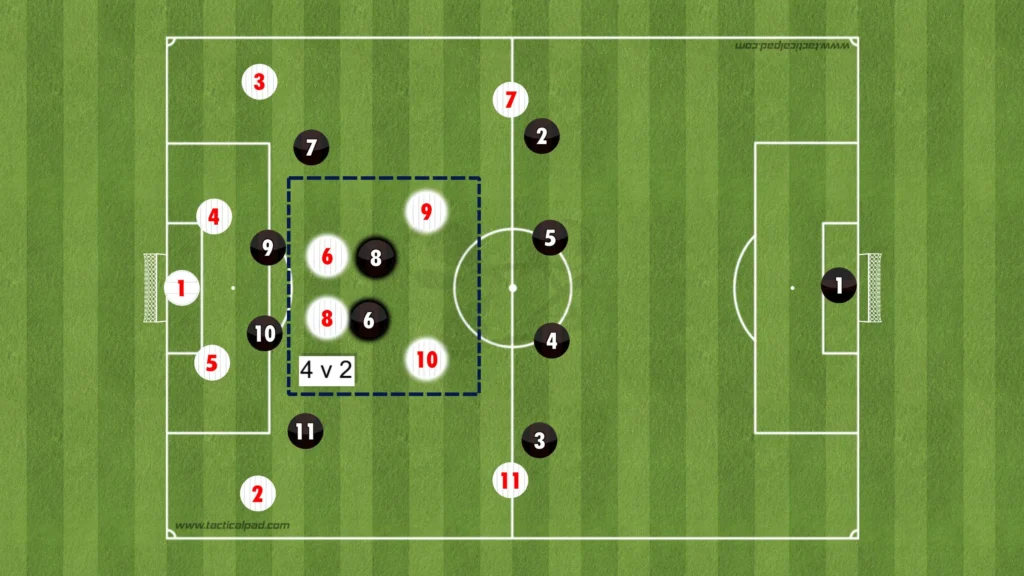
Lijnders mainly wants to beat the press by finding a dropping striker in the space between the opposition’s defense and midfield, who can bounce the ball to a holding midfielder, who then can progress the ball forward.
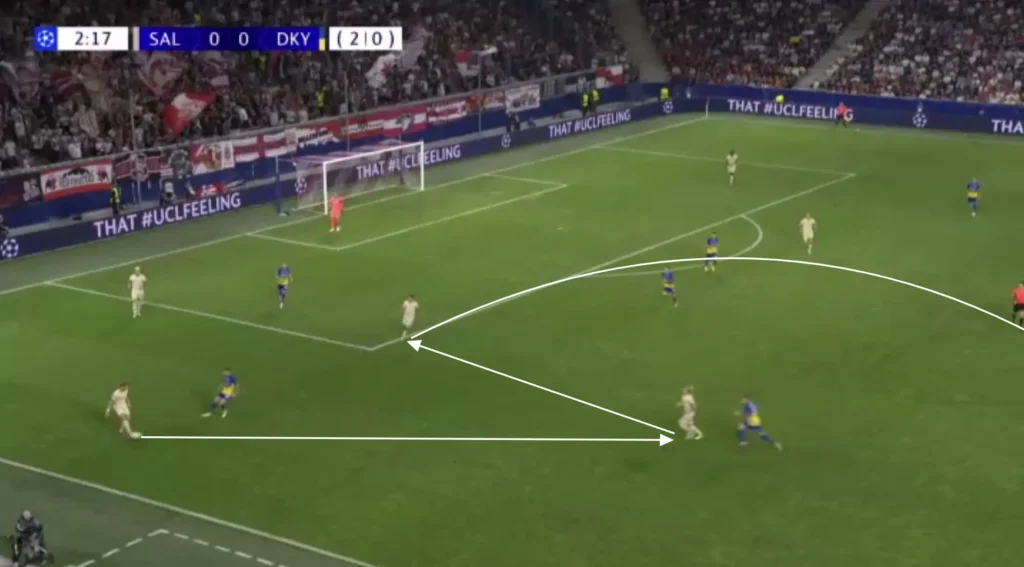
When Salzburg beat the press, the attackers will immediately make runs in behind, looking to exploit the space behind the opposition’s backline.
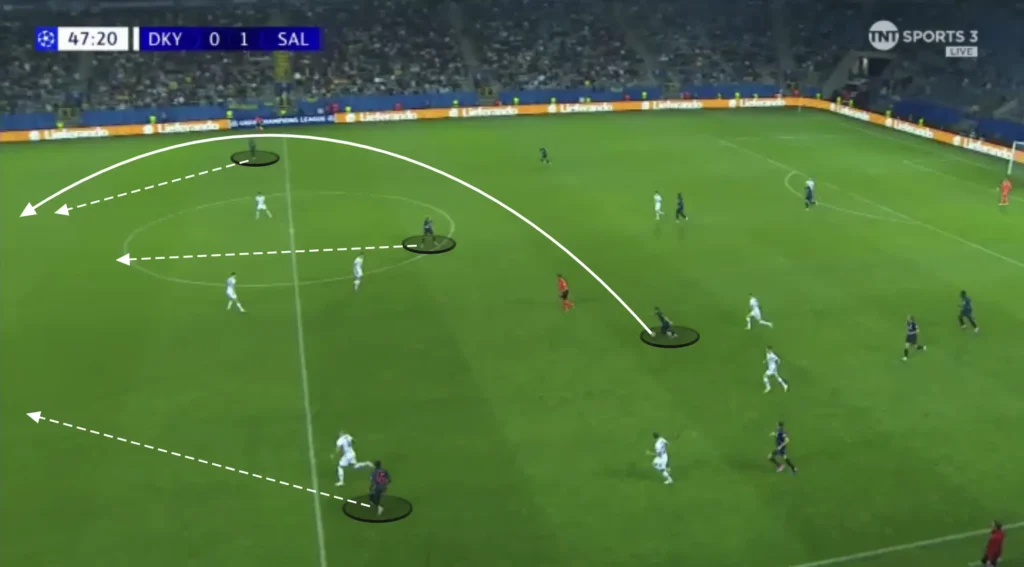
Salzburg are also not afraid to be more direct in the low build-up. If the opposition comes up and presses man-to-man, there will be numerical equality up top with Salzburg’s attackers against the opposition defenders. The goalkeeper will sometimes find an early longer ball up to the attackers, aiming to win 2v2 or 3v3 situations. The Salzburg attackers have good individual quality and will often win these battles to create goalscoring opportunities.
High Build-up
In the high build-up, Salzburg usually set up in a 1-4-3-3 formation.
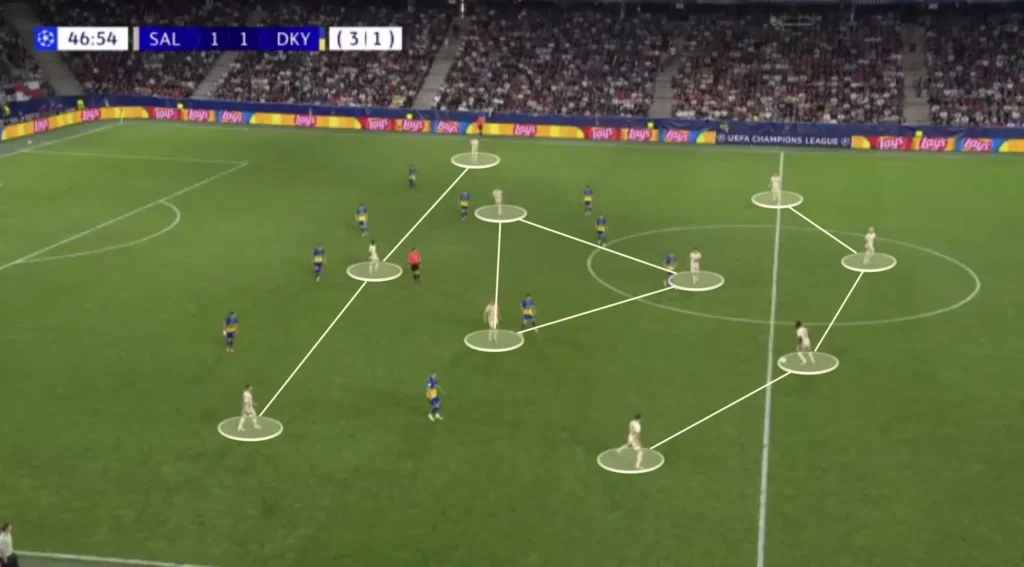
However, they will often rotate into a 1-2-3-5 formation.
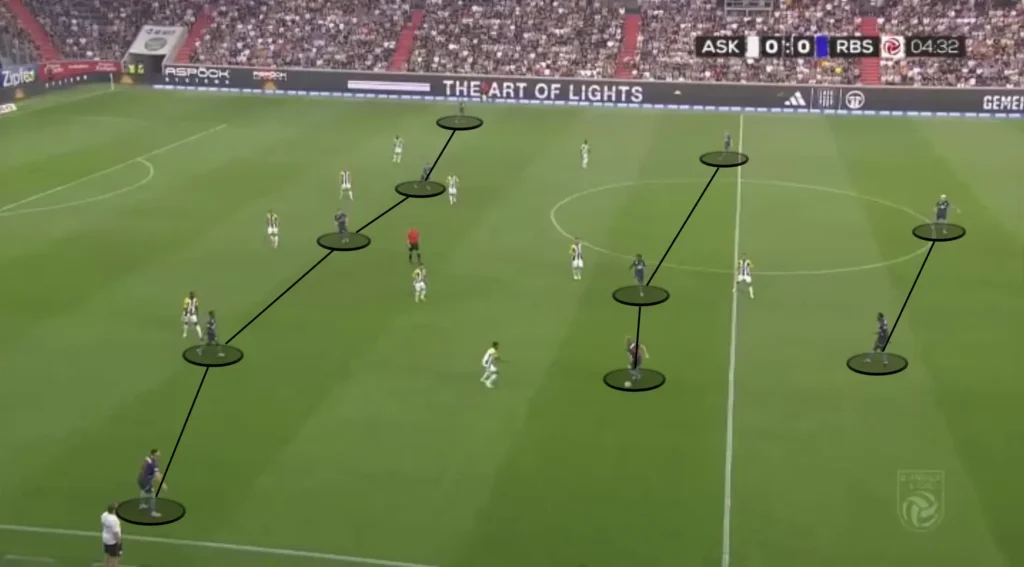
The 1-2-3-5 formation allows for a strong presence in the midfield, which helps in controlling the game and dictating the tempo. The two central defenders provide a solid foundation for recycling possession, while the three holding midfielders can effectively link play between defense and attack. The five forward players, including wingers and strikers, stretch the opposition’s defense, creating space and overloads in key areas.
Salzburg can get into the 1-2-3-5 formation either by inverting the wingers and pushing up the fullbacks or inverting the fullbacks and staying wide with the wingers.
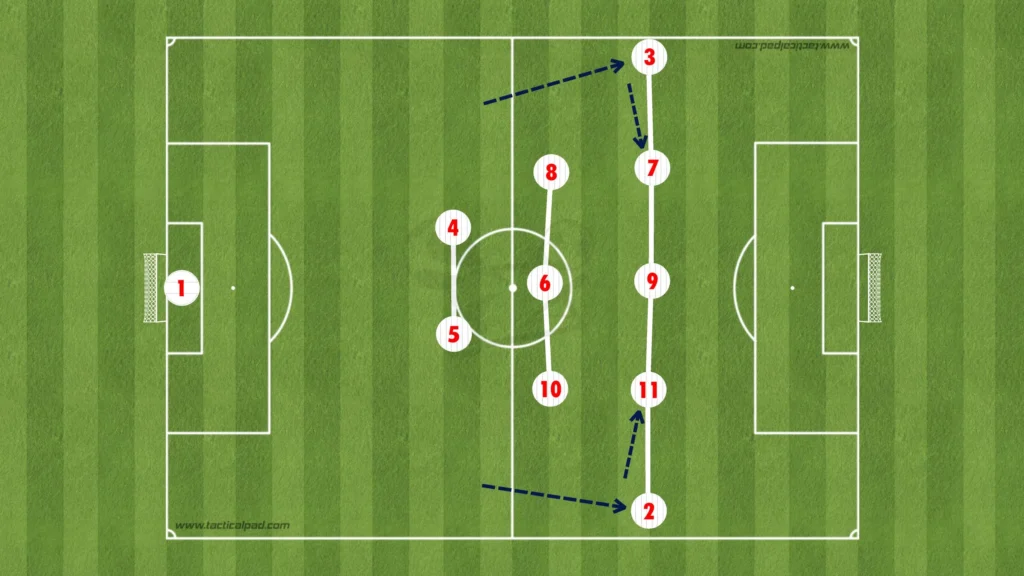
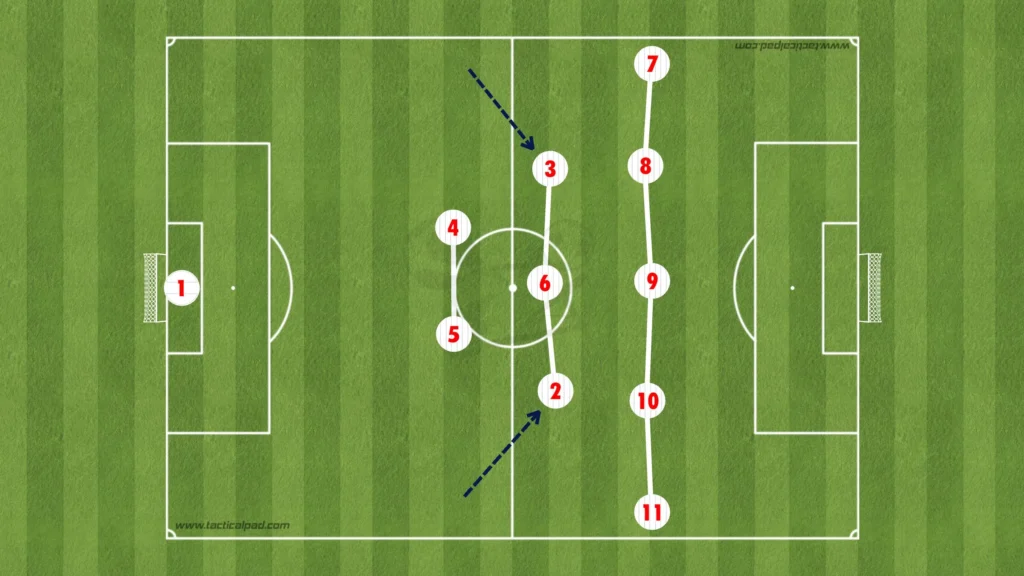
Additionally, Salzburg will often do one rotation on one side and the other on the other side to get into the 1-2-3-5 formation. Salzburg’s build-up aims always to get the players into their best positions. Therefore, Lijnders is not afraid to invert the fullback on one side and invert the winger on the other side. Here, Salzburg are set up in the 1-2-3-5 formation, with the right-back inverted into the holding midfield, the right-winger positioned on the wing, the left-winger inverted into the attacking midfield, and the left-back pushed up into a left-winger position.
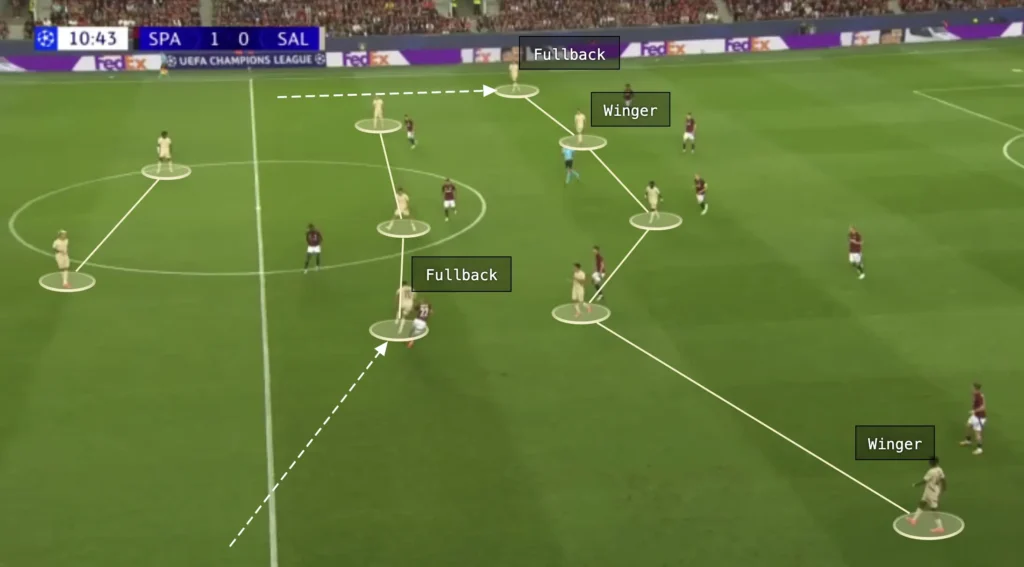
This flexibility allows Salzburg to be very fluid in the build-up, which can create questions and confusion for the opposition.
What Spaces Open Up?
Different spaces open up in the high build-up depending on Salzburg’s rotations. When the wingers invert, the opposition fullbacks usually follow, opening the space out wide for Salzburg’s fullbacks to push up into. Many wingers are not very active when defending and won’t track a run up the pitch from a fullback, which results in the fullback being completely open. Therefore, a Salzburg defender or midfielder can play a long ball to the running fullback, who can take the ball forward to create a crossing opportunity.
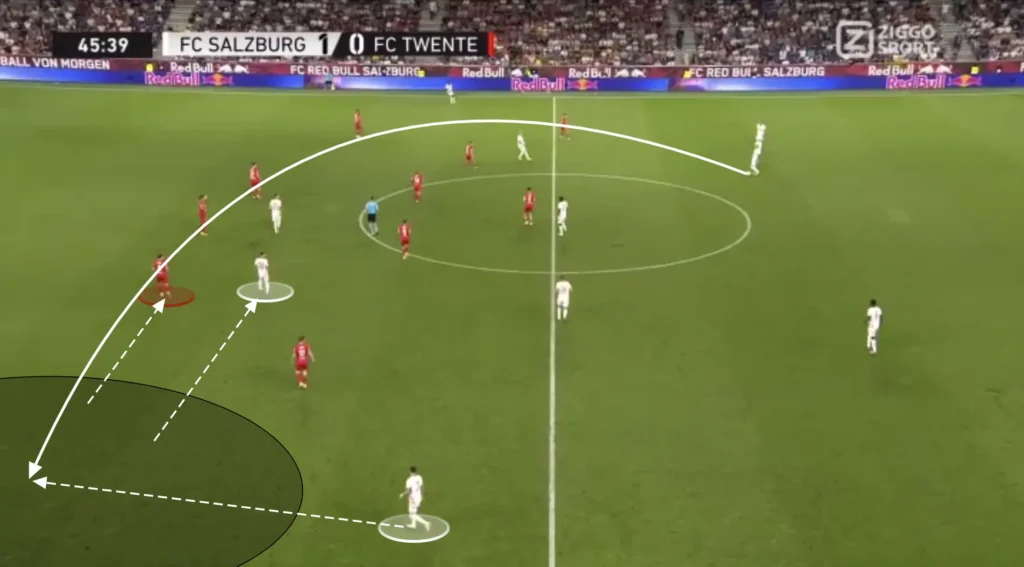
When the fullbacks invert, the opposition wingers usually follow to cover the run, which opens the passing lane from the center-back to the winger. The center-back can play the ball to the winger, who can attack the opposition fullback and combine with the attacking midfielder to create a 2v1 situation.
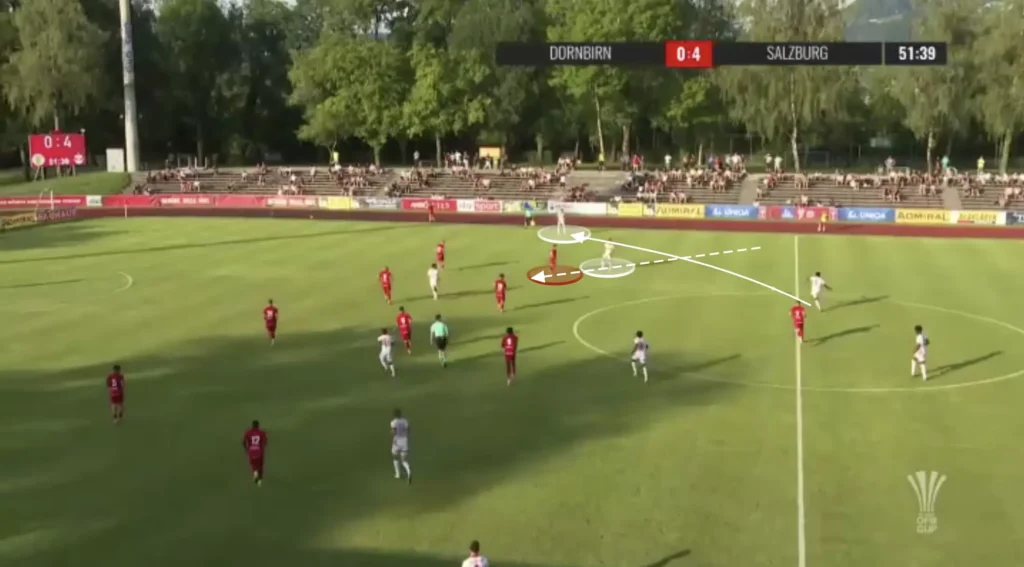
Fluidity
RB Salzburg’s fluidity in the build-up under Pep Lijnders has been a key aspect of their tactical evolution. The team often adopts a dynamic approach, shifting between formations to create numerical advantages and exploit spaces. Lijnders’ focus is always to get the players into their best positions, where they can make the most out of their individual skills. He emphasizes versatility, with players interchanging positions seamlessly to maintain possession and disrupt the opposition’s defensive structure. The defenders often move into midfield, attackers switch positions with each other, and central midfielders drop deep to assist in ball progression. This flexibility creates numerical superiority in different areas, allowing Salzburg to bypass the opposition’s press while maintaining control. The movement is coordinated and dynamic, with constant interchanging between lines, making it difficult for opponents to predict or disrupt Salzburg’s build-up play.
While it demands a lot of technical and tactical skills from the players, this fluidity has created new dynamics for Salzburg’s attacking style, offering new solutions and ways of beating the opposition’s press. It enhances their ability to control the game while opening up opportunities for incisive passes and creative plays.
Numerical Advantage in the midfield
Regardless of the formation, RB Salzburg will have many players in the center. Lijnders usually has a winger on each side and positions the remaining eight players in the middle.
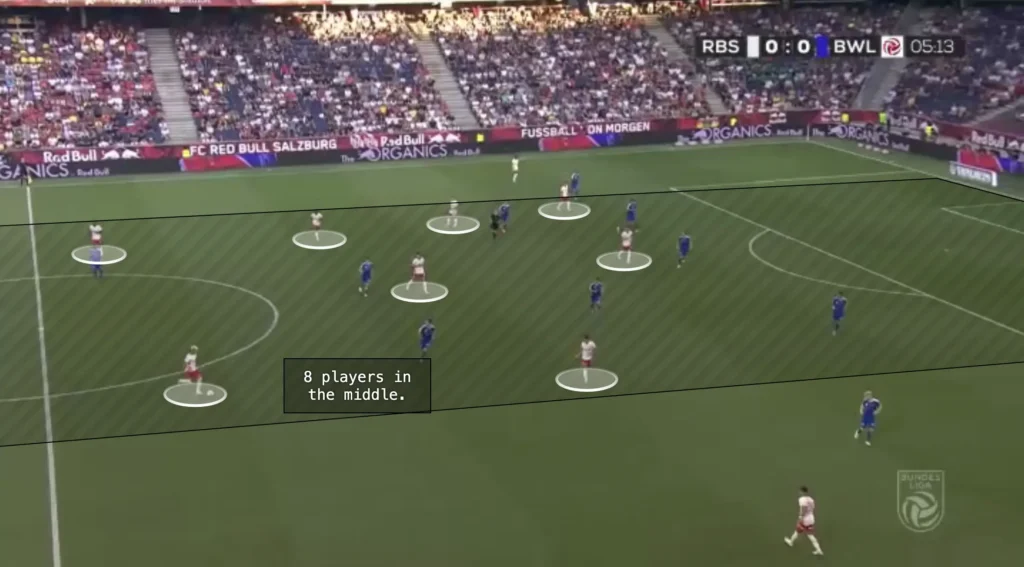
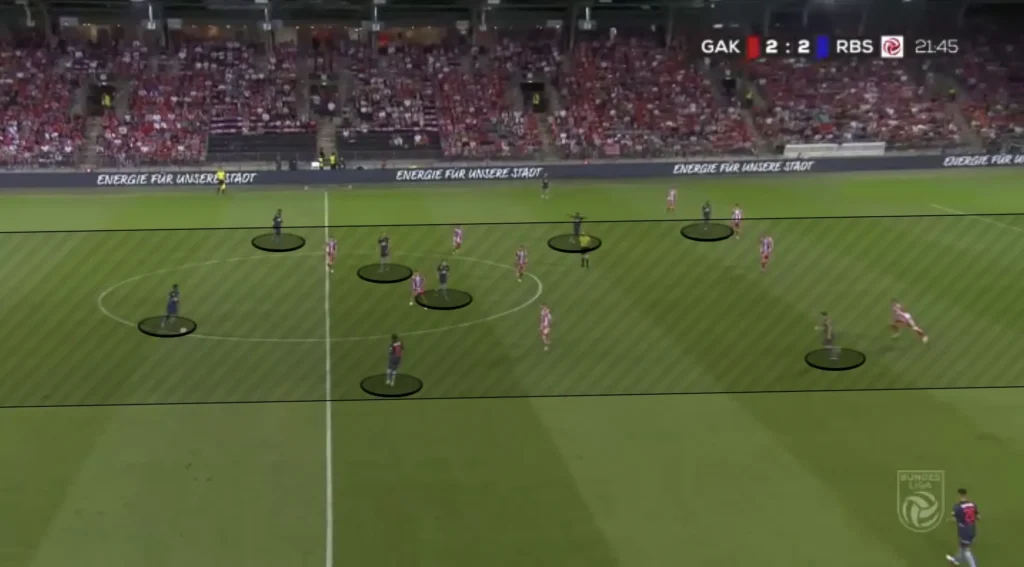
Having only the two wingers out wide and the rest in the middle creates more options in the center and less space between the players. Lijnders likes this because he prioritizes playing through the middle. He needs one player out wide to pull the opposition apart while the rest create numerical advantages in the midfield areas.
When a team outnumbers the opposition in the midfield, it can more easily retain the ball, exploit spaces, and progress the ball through the center. This advantage forces the opposing team to chase the game, which can lead to defensive errors and create opportunities for breaking down their defense. At the same time, it builds good conditions in defensive transitions since it allows more players to counterpress when they lose the ball.
Another purpose for keeping many players in the middle is to shorten the distance between them. This shortens the length of the passes, which naturally shortens the time between passes. This means the opposition players will have less time to push up and press, giving the Salzburg players more time and control.
High Backline (Off)
A massive aspect of Lijnders’ high build-up is to have the defenders high up. This helps in the counterpress because they get closer to the center. Having more players close to the center who can win the ball back makes it difficult for the opposition to do anything when they win possession. Furthermore, the high backline shortens the distance between players, shortening the time and length of the passes and preventing the opposition from pushing up their defense.
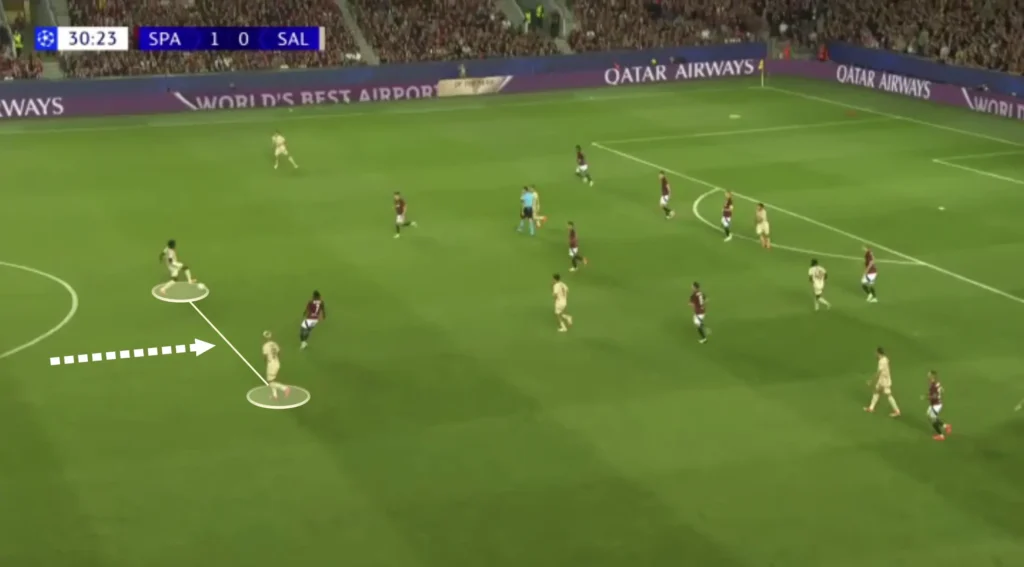
Using the Goalkeeper
Pep Lijnders is a big fan of using the goalkeeper in the build-up. Using the goalkeeper in the build-up phase offers numerous tactical advantages. By involving the goalkeeper, RB Salzburg can create numerical superiority at the back, making it easier to evade the opponent’s press and maintain possession. This additional player allows for more passing options, reducing the risk of losing possession and enabling smoother transitions from defense to attack. The goalkeeper can also act as a pivot, switching play across the field to exploit weak points in the opposition’s formation. Furthermore, involving the goalkeeper helps in drawing the opposition forward, creating space higher up the pitch for attackers to exploit.
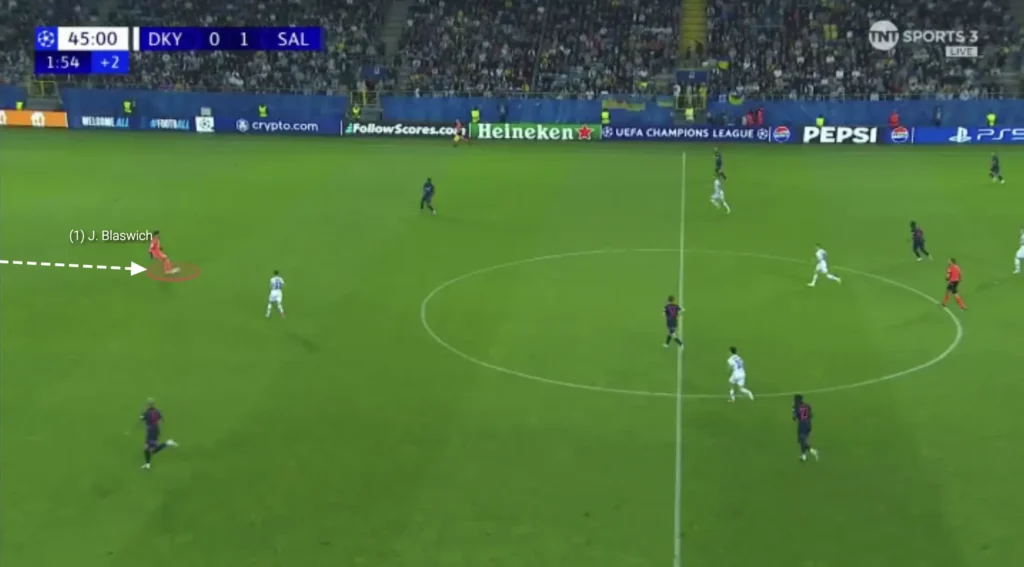
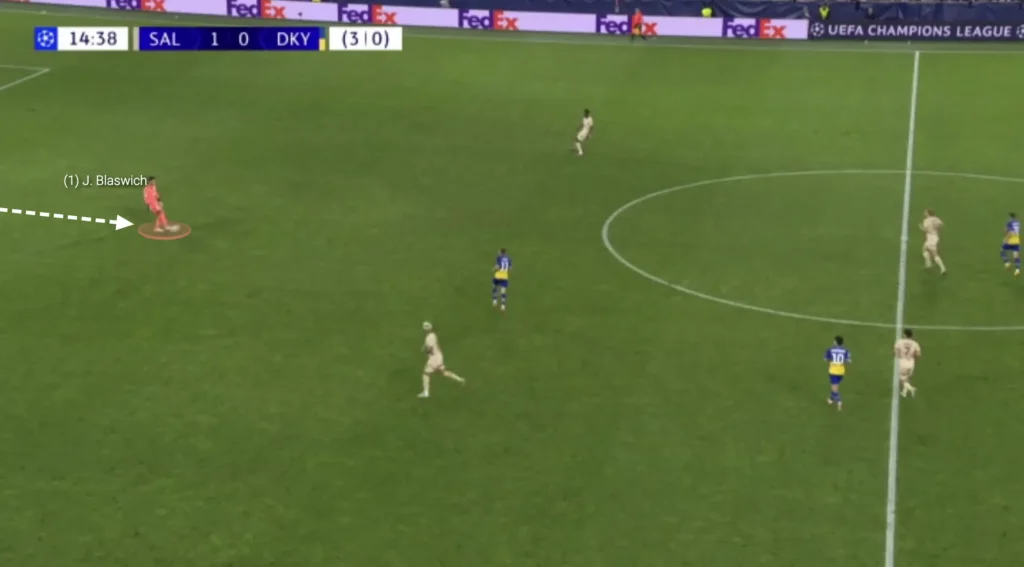
Finding the Pockets
Lijnders’ players always try to find the attacking midfielders in the pockets. These “pockets” refer to the spaces between the opposition’s defensive and midfield lines, where the attacking midfielders can receive the ball in more advanced positions. By positioning themselves intelligently in these pockets, the attacking midfielders can turn quickly and face the opposition’s goal, creating opportunities for through balls, driving runs, or direct shots. This positioning forces the opposition to make difficult decisions. If an opposition defender steps up and closes down the attacking midfielder, he potentially leaves space behind. If he stays back, he allows the midfielder time on the ball. The Salzburg defenders and holding midfielders will look for straight passes, breaking the opposition lines and finding the attacking midfielders who can turn and drive at the defense.
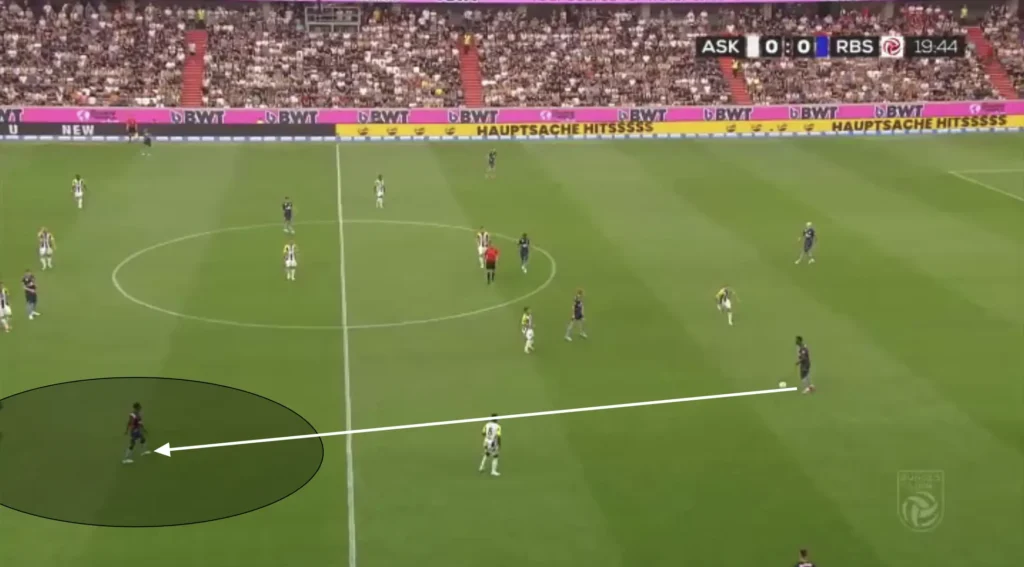
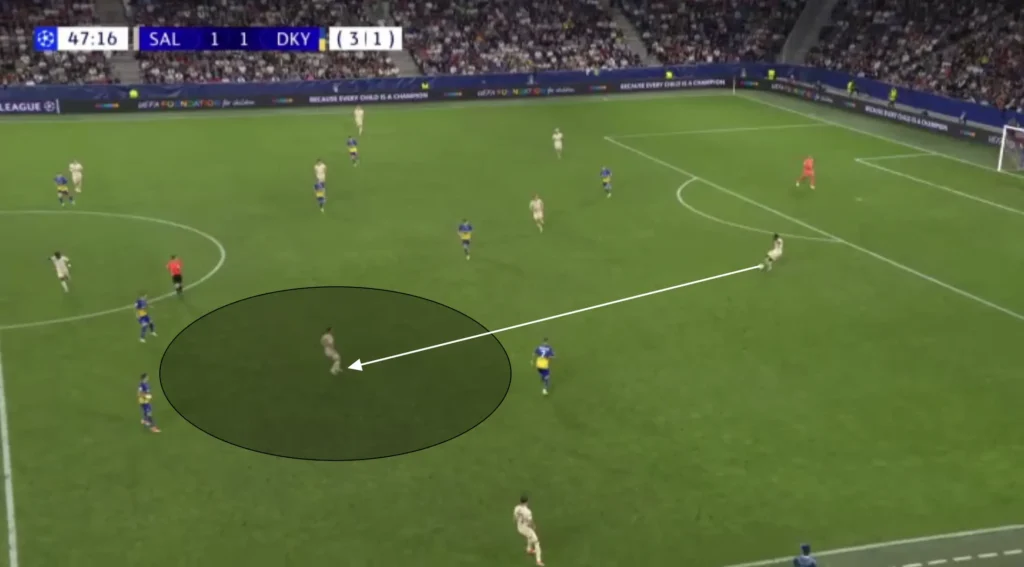
Finding these pockets is crucial for maintaining fluidity in attack and ensuring that the team can progress the ball effectively through the middle of the pitch.
Linking with the Striker
Pep Lijnders likes to create central overloads when attacking the opposition. Therefore, the Salzburg striker often drops during the build-up. When the striker drops, Salzburg unlock more ways of beating the opponent’s defense. They can pass the ball to the striker, who can find a midfielder in between the lines or play a one-touch pass out to the winger.
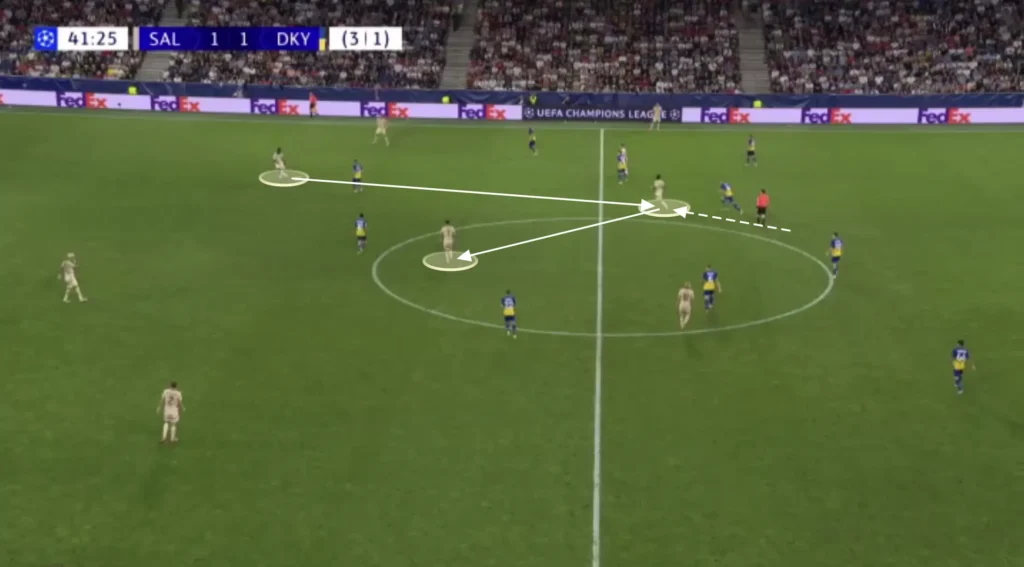
If a center-back pushes up on the striker, the space in behind opens up. When that happens, Salzburg will exploit the space in behind with runs from the wingers or attacking midfielders.
Numerical Advantage Against the Opposition Backline
Another massive aspect of Salzburg’s high build-up is their ability to create numerical advantages against the opposition’s defensive line. Playing with a front five means the forward line naturally becomes numerically superior against a back four, which they are great at taking advantage of.
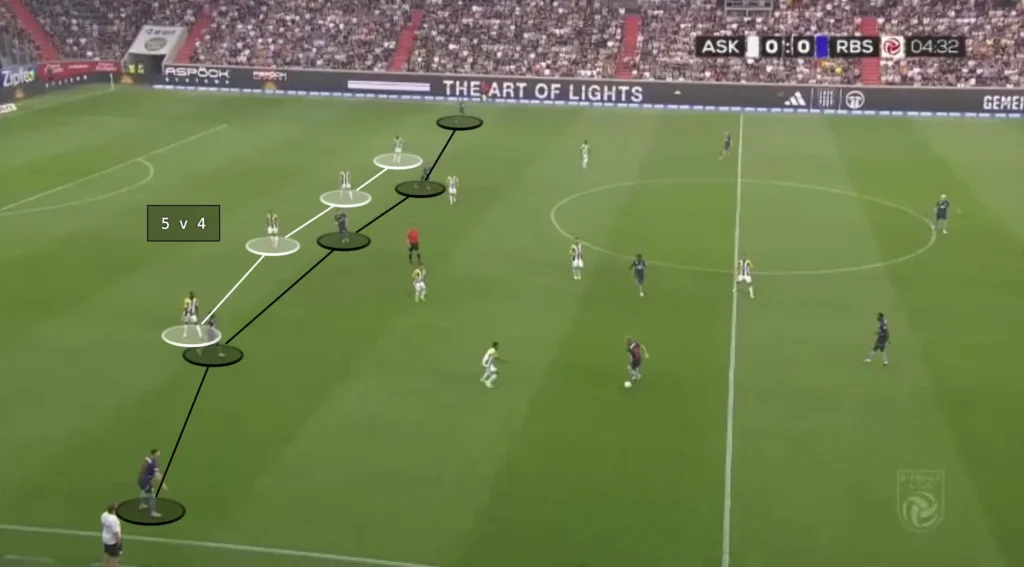
They mainly exploit this by creating 2v1 situations against the opposition fullback. When the defending team is positioned on one side, the weak-side fullback becomes vulnerable to the switch of play due to the 1v2 against Salzburg’s winger and attacking midfielder. Salzburg’s attacking midfielder will often make a run in behind, forcing the fullback to follow that run, and opening the space for the winger out wide. Lijnders’ team often capitalizes on this by getting the ball to the winger and creating many opportunities from 2v1 situations on the wing and in the half-spaces.
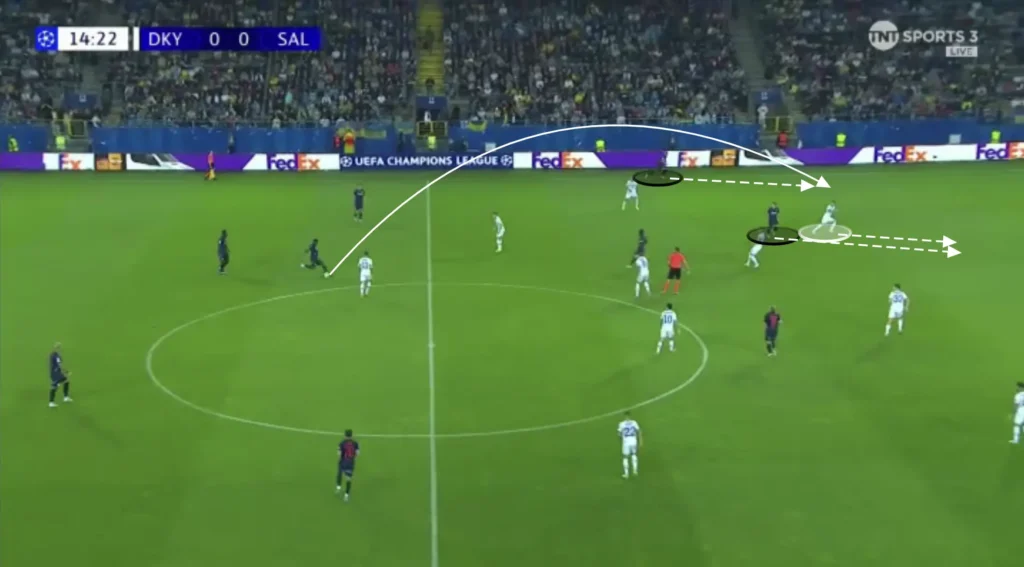
Attacking the Half-Space
Lijnders’ players usually look to create chances by attacking the space between the opposition center-back and fullback. They primarily do this from the wide areas with underlaps from the attacking midfielders. When the winger receives the ball out wide he will attract the opposition fullback. This opens the space between the fullback and the center-back, which allows Salzburg’s attacking midfielder to make the underlapping run into this space. The ball can be played to the underlapping player, who can cross the ball into the box or attack his defender in a 1v1 situation.
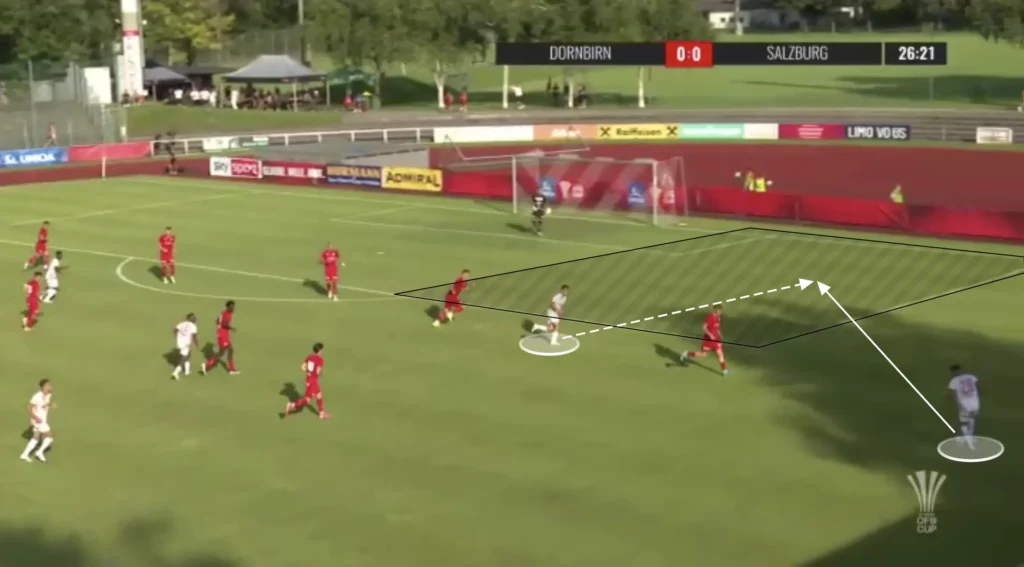
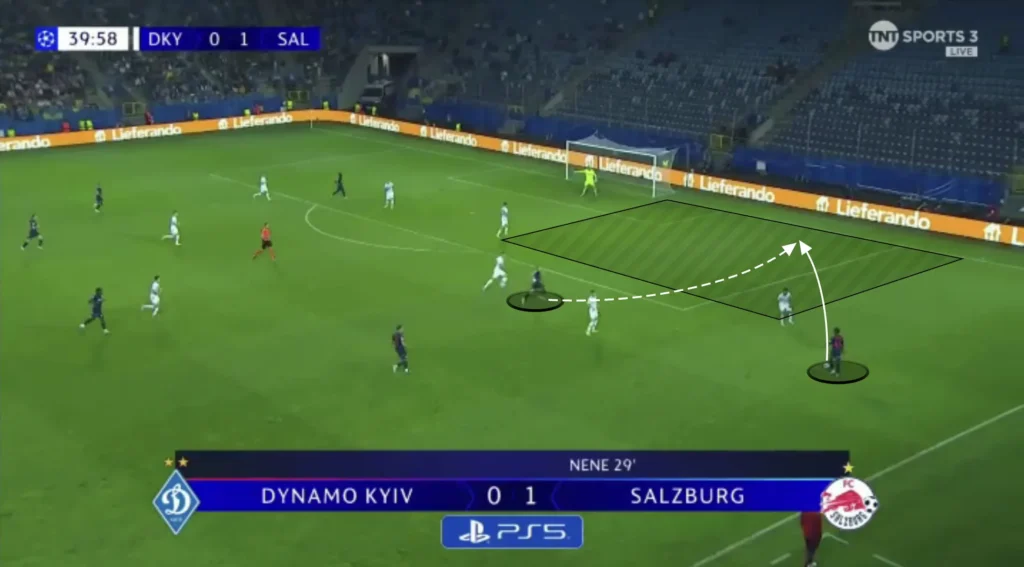
The winger does not have to play the ball to the underlapping player. The run from the attacking midfielder will often drag away an opposition defensive midfielder, which opens the space inside. The winger can take the ball inside and shoot or find a pass to a free player in front of the backline.
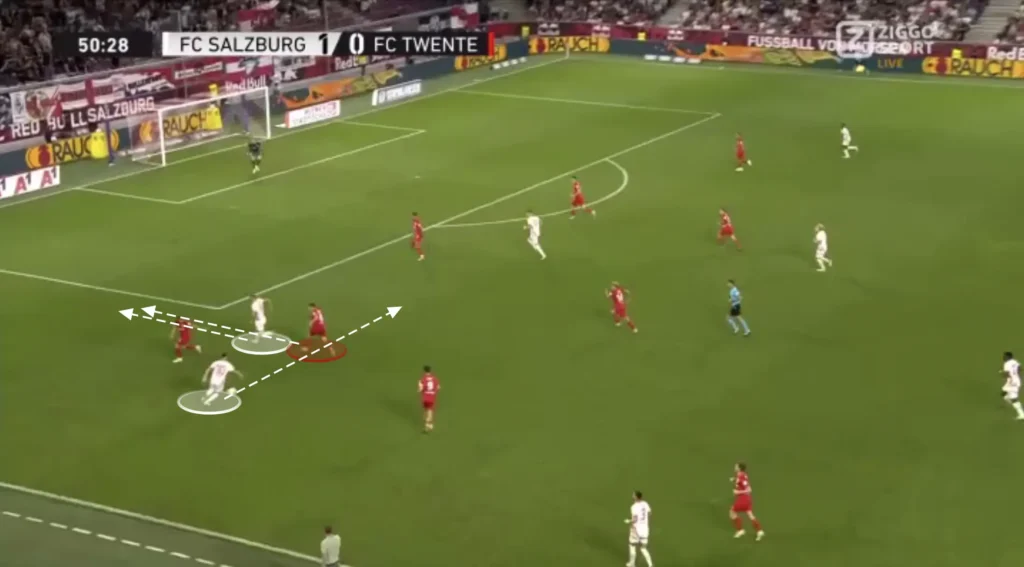
Overlaps
RB Salzburg will also use overlaps to produce opportunities in the final third. When the winger gets the ball and the fullback is nearby, the fullback can make the overlapping run, creating a 2v1 against the opposition fullback.
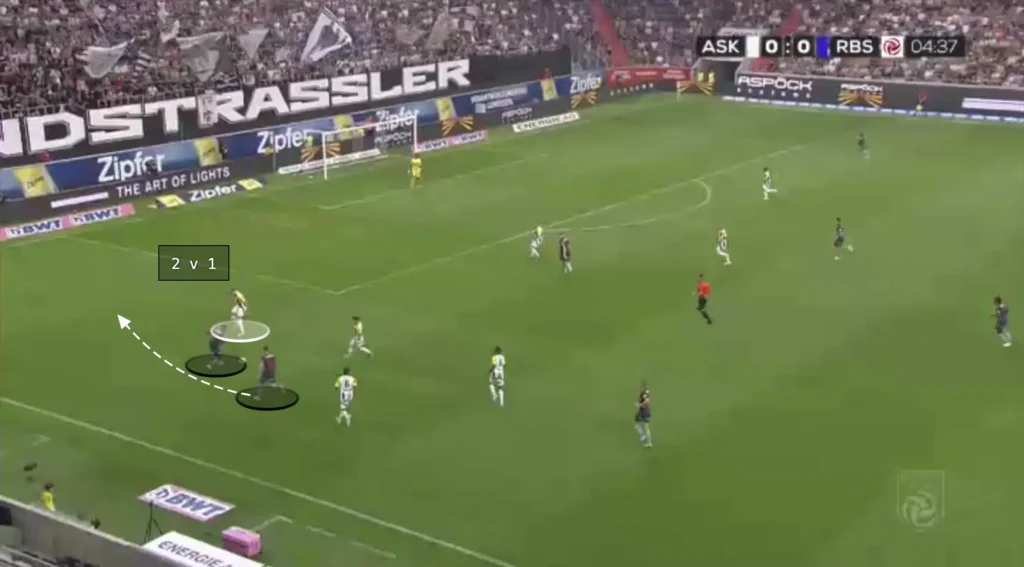
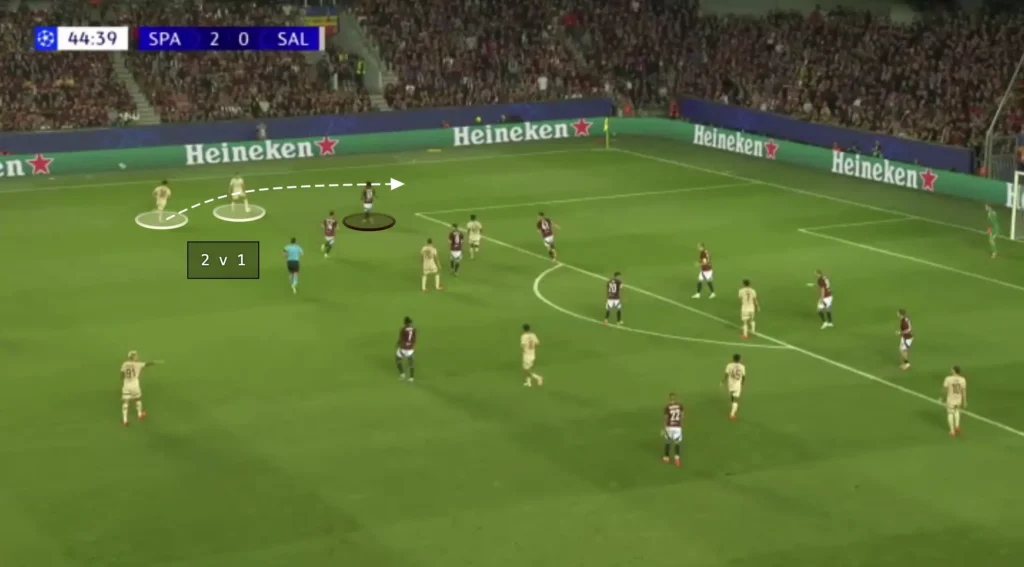
If the opposition fullback drops to cover the overlapping run, the winger could cut inside, taking a shot or combining with a midfielder. If the fullback covers the center, the ball can easily be played to the overlapping player, creating a crossing opportunity.
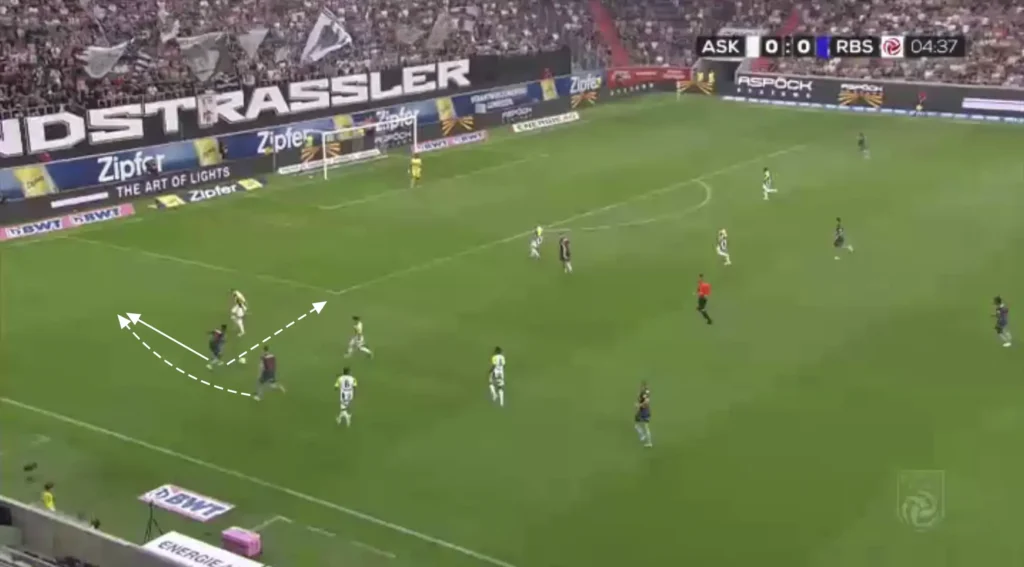
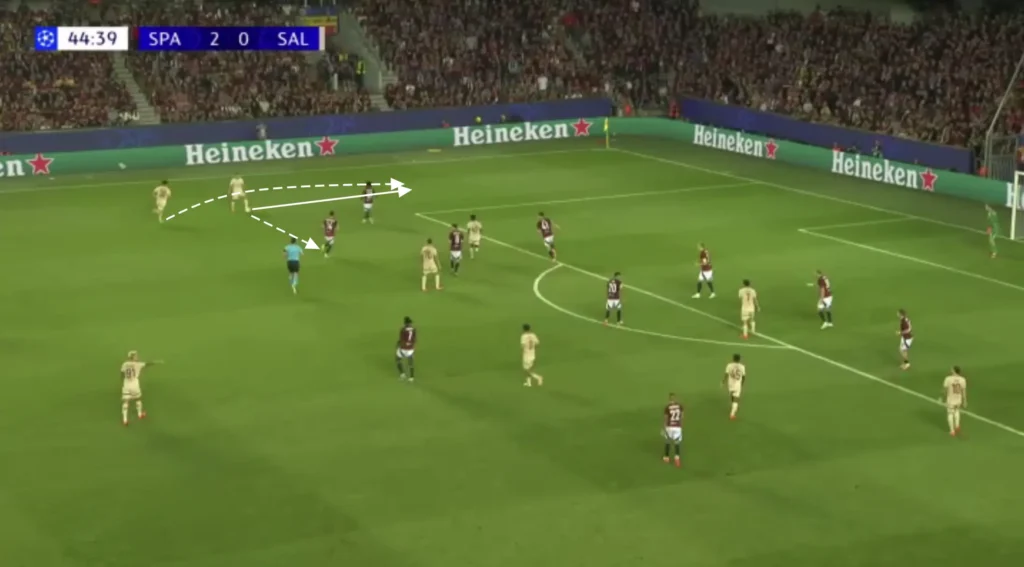
Defending
High Press
Pep Lijnders usually wants to press the opposition high up the pitch. Their pressing structure will depend on the opposition, but they primarily press in a 1-4-3-3 formation.
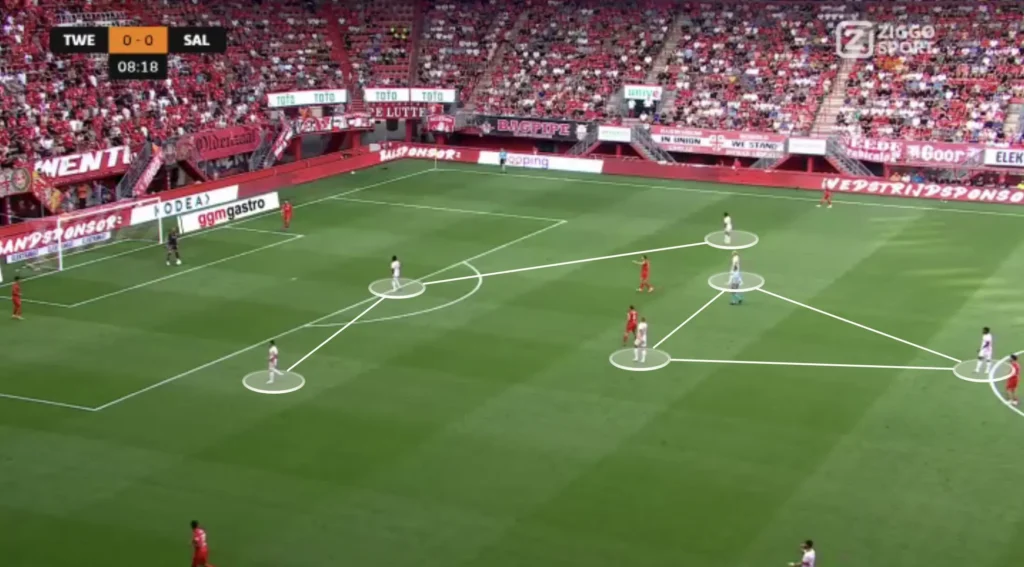
The pressing striker will try to close off one opposition center-back by making angled pressing runs, forcing the opposition to one side. The far-side winger often comes up to close the pass to the far-side center-back, making it even more difficult for the opposition to switch sides. The rest of the players will shift across and try to win the ball by using the touchline as an extra defender.
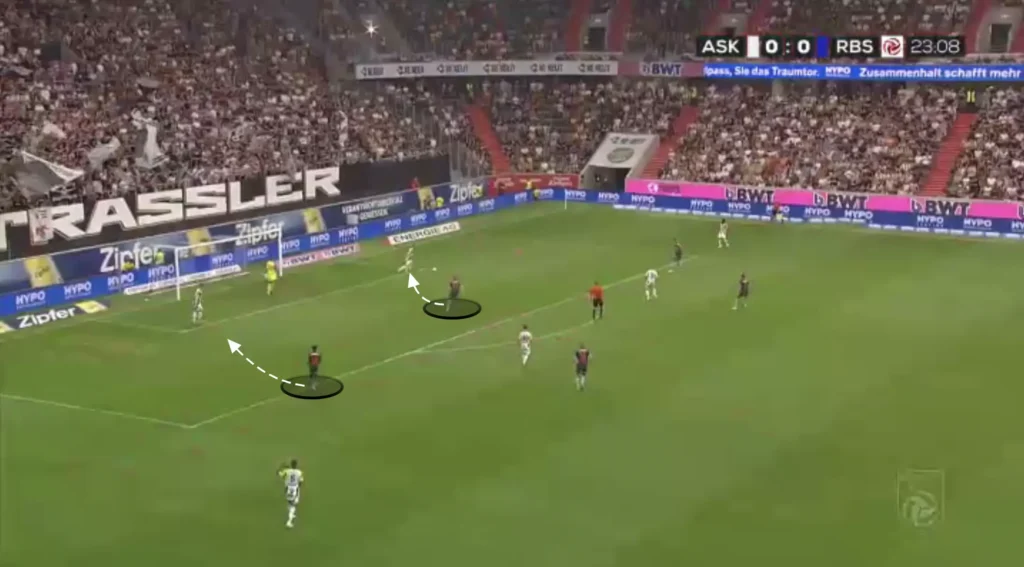
When the opposition gets pushed out to one side, Salzburg will be extremely aggressive and intensely press to win the ball. Every opposition player close to the ball will be marked by a Salzburg player, limiting the options for the ball-carrier, often resulting in a long ball and loss of possession.
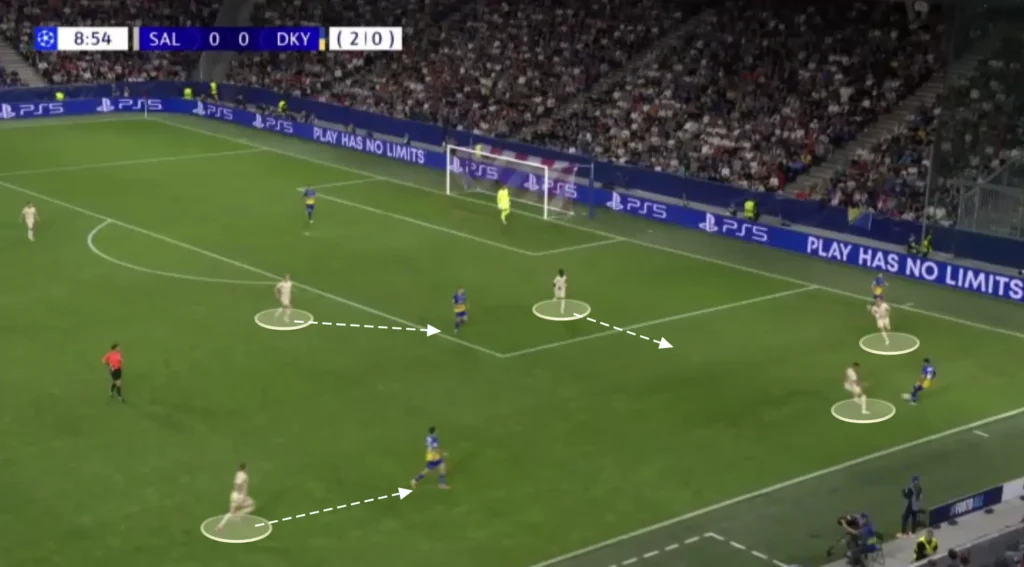
The benefit of Salzburg’s pressing system is that it gives them a numerical advantage against the opposition attackers, which gives them more control when defending long balls.
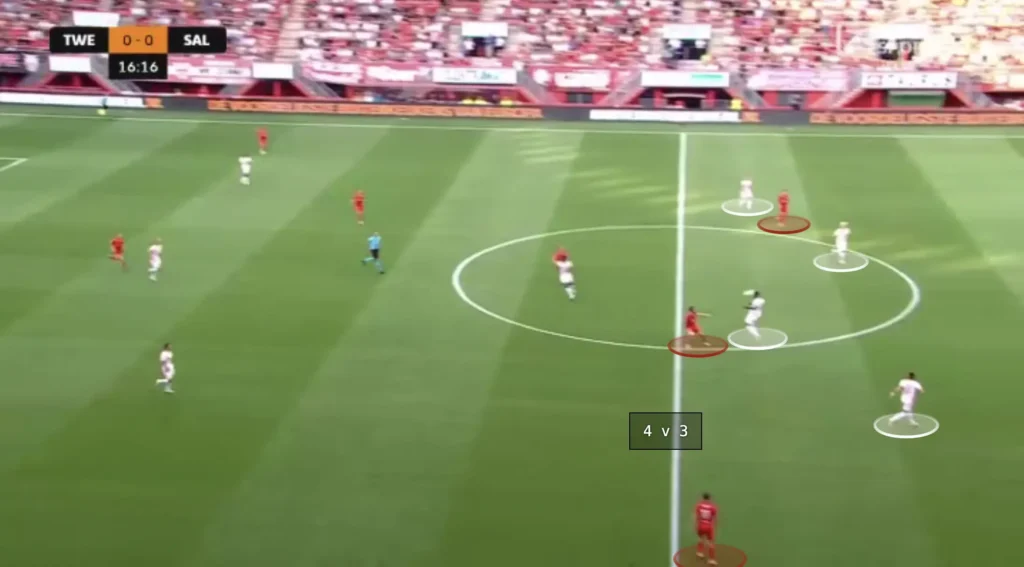
Low Press
RB Salzburg’s base formation when defending is the 1-4-1-4-1 formation. They look to set up in a mid-block, always trying to close the center and force the opposition out wide. Defending in a 1-4-1-4-1 formation is centered around maintaining a compact and organized structure that makes it difficult for the opposition to penetrate through the middle. The key feature of this setup is the presence of a single defensive midfielder (the “1” in front of the back four) who plays a crucial role in shielding the defense and breaking up attacks. The back four stays narrow and disciplined to protect the central areas. Meanwhile, the midfield line of four works in unison to press the opposition, forcing them wide where the fullbacks can engage. The lone striker remains high, ready to apply pressure on the ball when it enters the defensive zones.
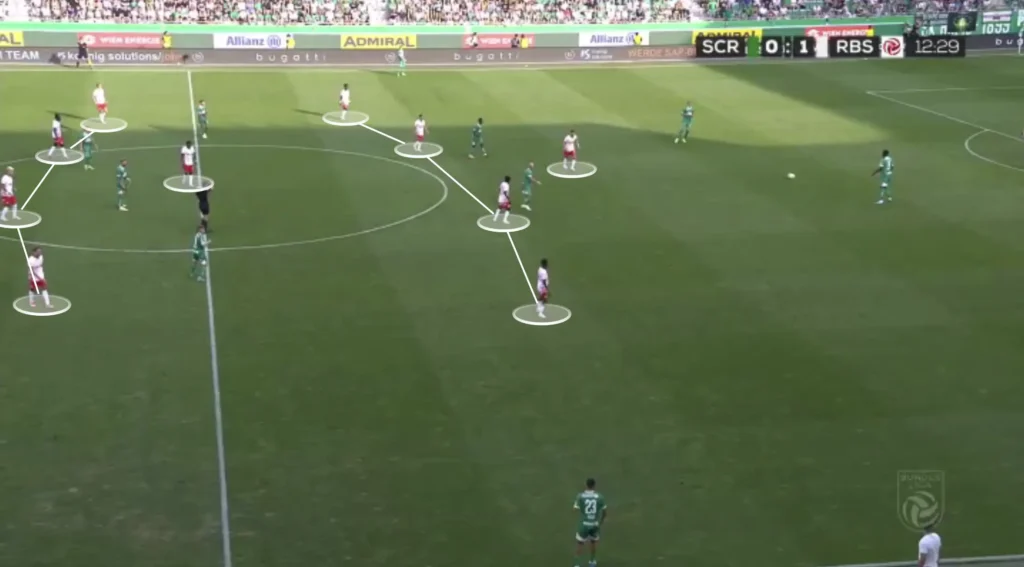
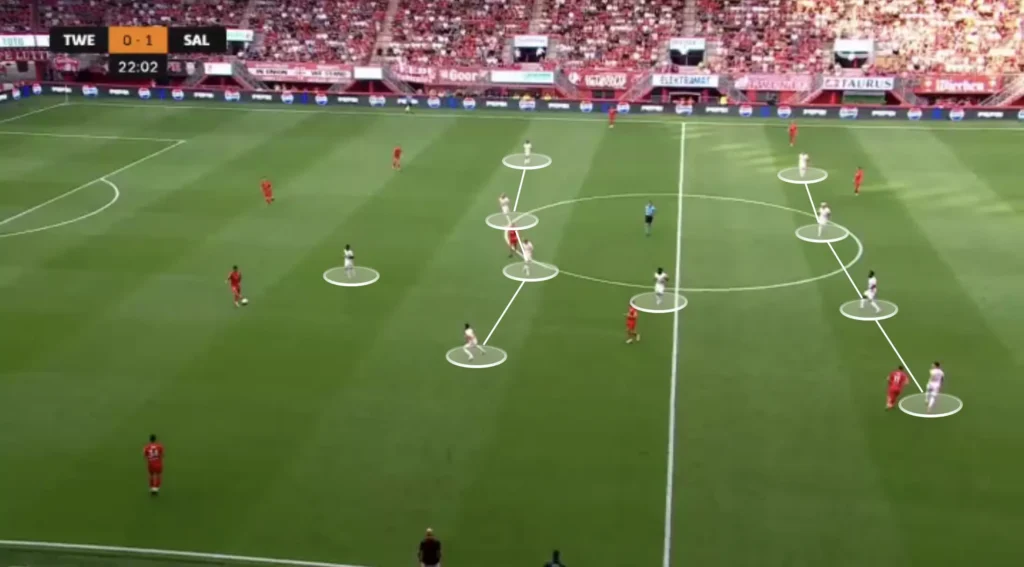
When defending in a 1-4-1-4-1 formation, the opposition backline will have a numerical advantage against the striker when building up. When the striker pushes up to press one of the center-backs, the ball can be played to the other center-back, who can take the ball forward. A Salzburg number-eight might have to push up to stop this center-back from advancing too far. If the eight pushes up, space opens up in the midfield. Therefore, the number-six must push up to stop the opposition from exploiting this space when a number-eight breaks out.
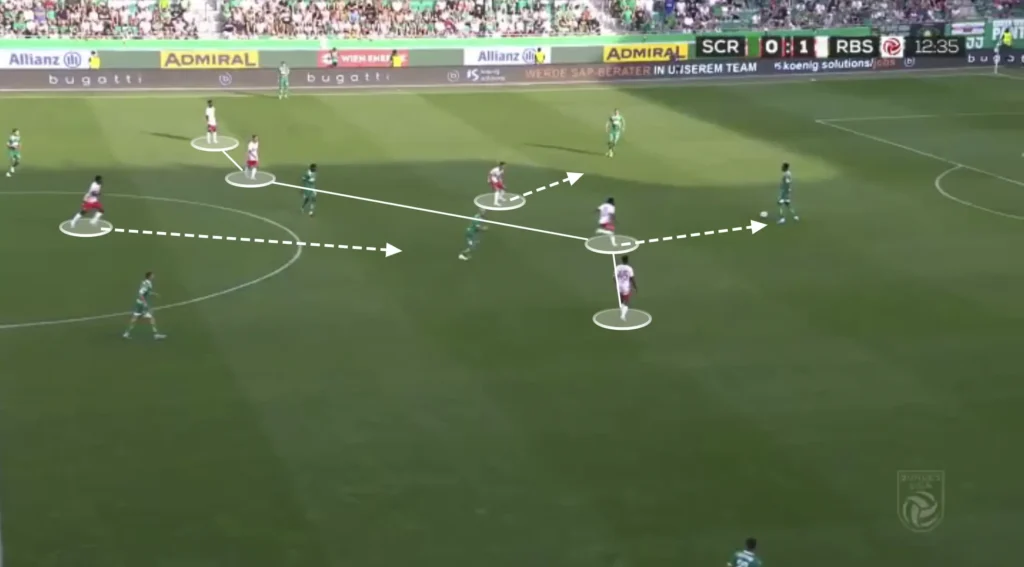
High Backline (Def)
One tool that helps to be compact is to play with a high backline, making the space to the midfield line as small as possible. Lijnders’ players do this and usually try to keep the highest line they can without leaving the space behind them too open. Defending with a high backline involves positioning the defensive line closer to the midfield, rather than near the goalkeeper. This tactic compresses the space available for the opposing team to operate, disrupting their build-up play and increasing the chances of winning the ball back quickly.
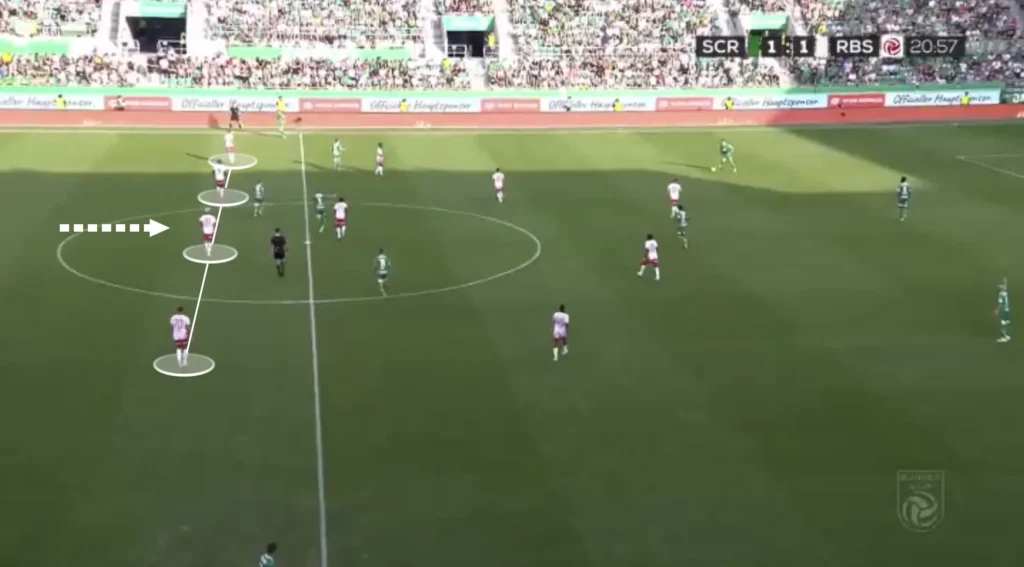
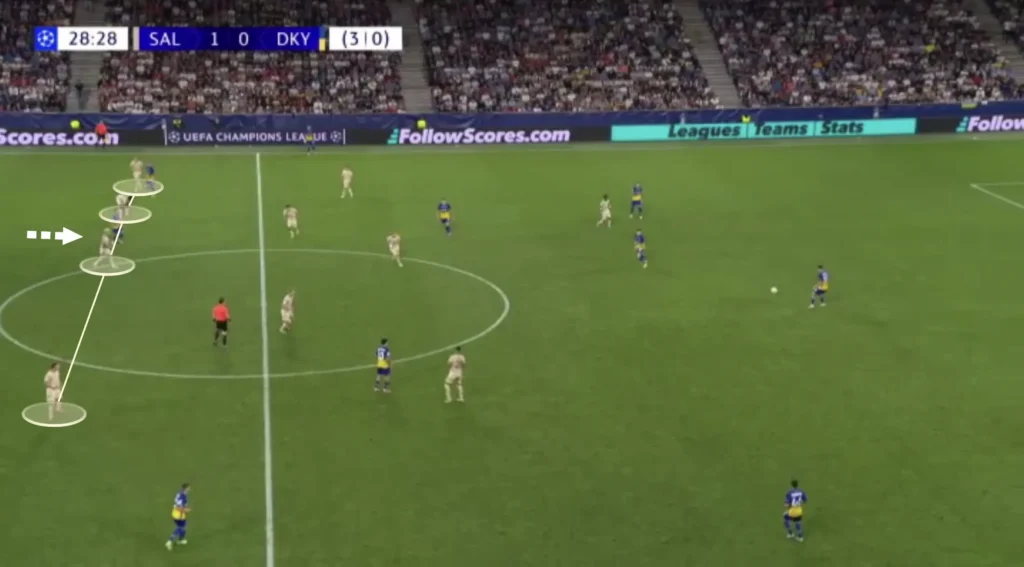
A high backline also allows defenders to support the midfield more effectively, creating numerical superiority in central areas and facilitating quicker transitions from defense to attack. However, it requires defenders with good pace and positional awareness to deal with long balls and prevent opposing attackers from exploiting the space behind. This approach demands constant communication and coordination among the backline to maintain a cohesive and effective defensive structure.
Everyone must be in the same line when defending with a high backline to maintain an effective offside trap, ensure cohesive coverage, and reduce gaps that attackers can exploit. A well-aligned defensive line makes it easier to catch opposing forwards offside, preventing them from receiving the ball in dangerous positions. Additionally, this alignment helps defenders support each other, allowing for quick transitions and coordinated movements to tackle, intercept, and clear the ball.
Squeezing the Pitch
Additionally, Lijnders always wants his team to squeeze the pitch when defending. This means constantly pushing the team up as much as possible. Every time the opponent plays a slow, sideways pass or a back pass, Salzburg’s first line of pressure pushes up, with the rest of the team following to stay compact. When the next pass comes, they push up even more, forcing the opponent back even more. They do this because it pushes the opponent further away from Salzburg’s goal, making it harder to create chances.
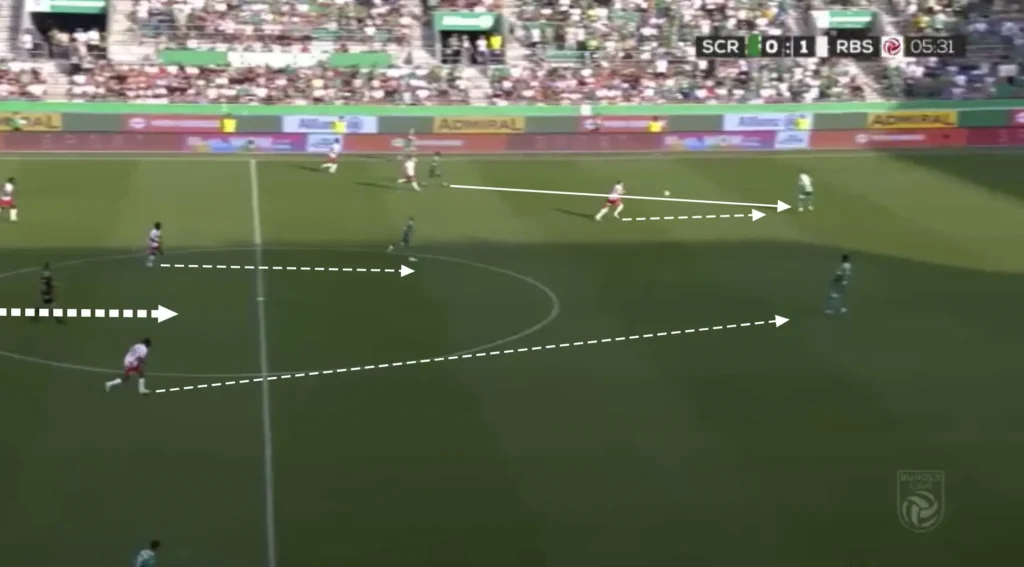
Transitions
Defensive Transitions
Positioning many players centrally, creating a numerical advantage in the midfield, creates good conditions in defensive transitions. Many players close to the ball after losing possession means that many players can work towards regaining possession. Lijnders’ players are also very aggressive in the first seconds after losing the ball. The four or five players closest will immediately jump on the opposition player with the ball and close the distance to cut off any passing lanes. This approach disrupts the opponent’s transition from defense to attack, forcing errors and creating opportunities to regain control in dangerous areas.
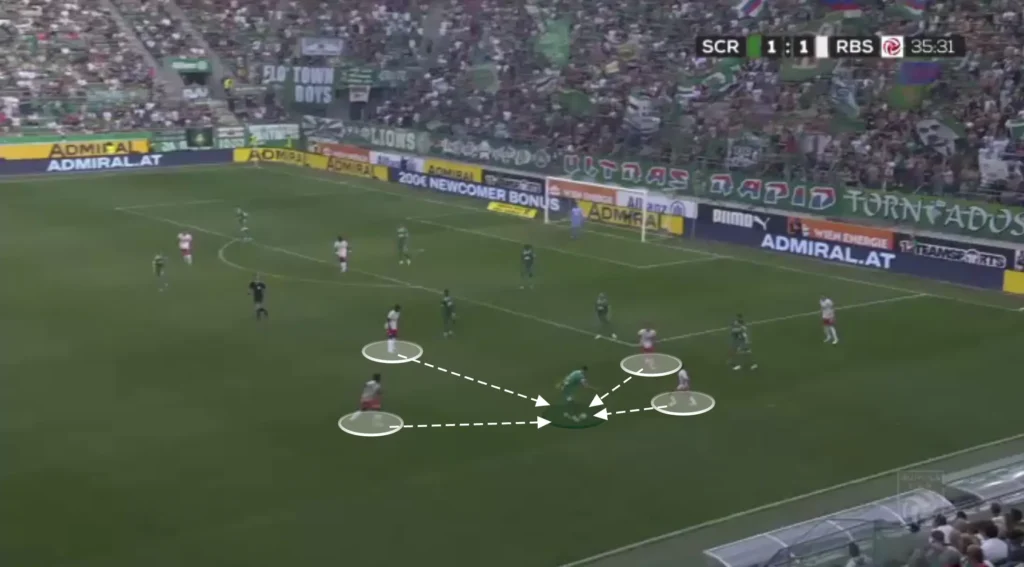
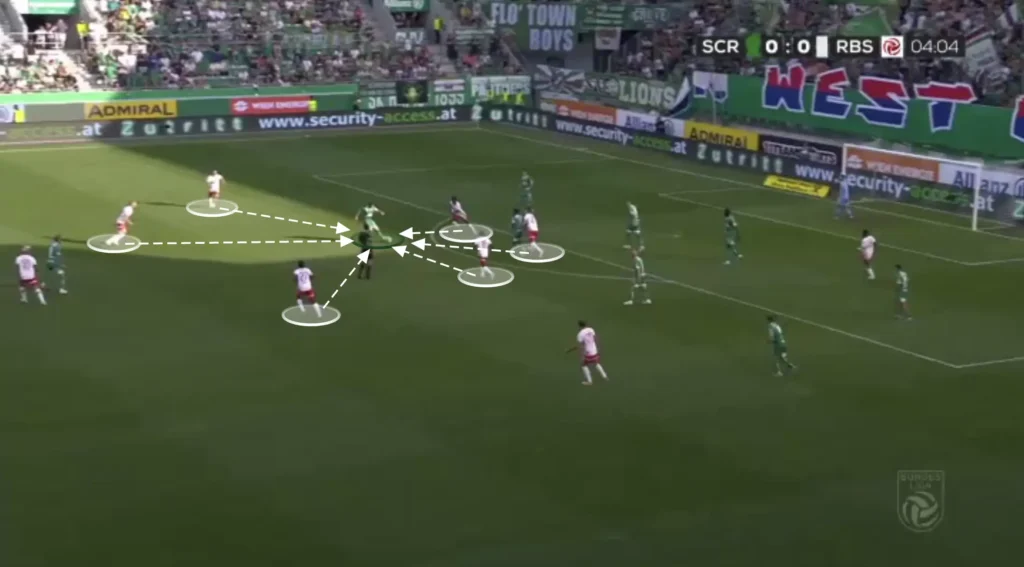
Counterpressing like this keeps Salzburg on the front foot, allowing them to dominate possession and create more scoring opportunities. However, it requires exceptional fitness, tactical discipline, and teamwork.
In August 2023, Lijnders spoke about his emphasis on defensive transitions in an interview with The Training Ground Guru. (https://trainingground.guru/articles/pep-lijnders-liverpools-intensity-identity)
“One of our main principles is counter-pressing. Jürgen says it isn’t a proposal, it’s a law. That’s what makes us, us. Counter-pressing is the moment when you lose the ball. At that moment, do you go back to defend behind the ball, or do you want to use that moment to create and score? You use that moment to attack again, because many times the opposition in this moment is not well organized.”
Offensive Transitions
Pep Lijnders also wants his team to counterattack in their offensive transitions. When winning the ball back, the team transitions quickly from defense to attack, utilizing the speed and movement of their forward players. Lijnders emphasizes vertical passes to exploit spaces left by the opposition, often targeting wide areas or gaps between defenders. Salzburg’s counterattacks are well-organized, with players making intelligent off-the-ball runs to create overloads and support the ball carrier. This quick, direct style catches opponents off guard, making Salzburg a dangerous team on the break. Additionally, Salzburg’s aggressiveness means they have many players high up when defending, which enables them to incorporate more players into the counterattacks.
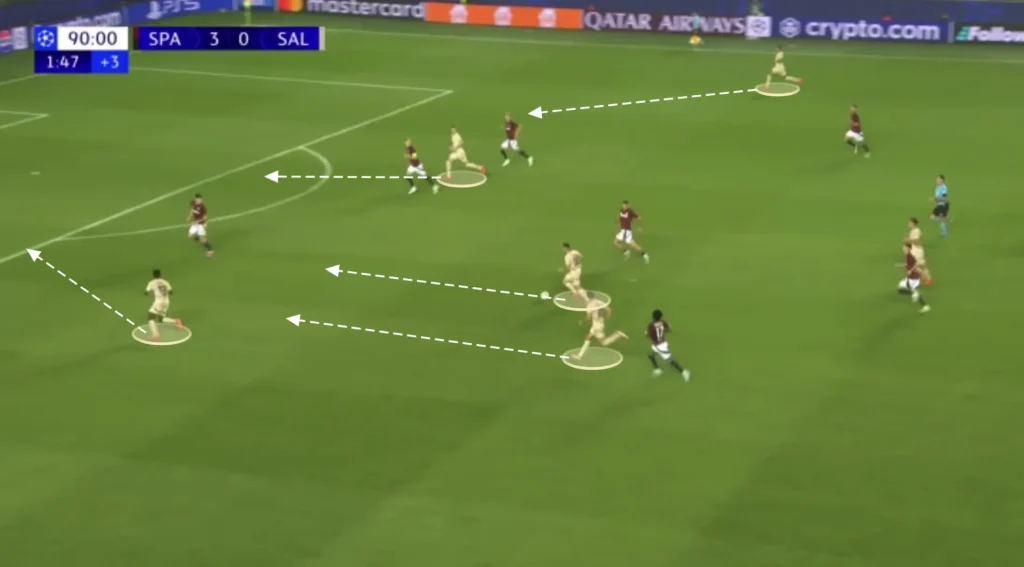
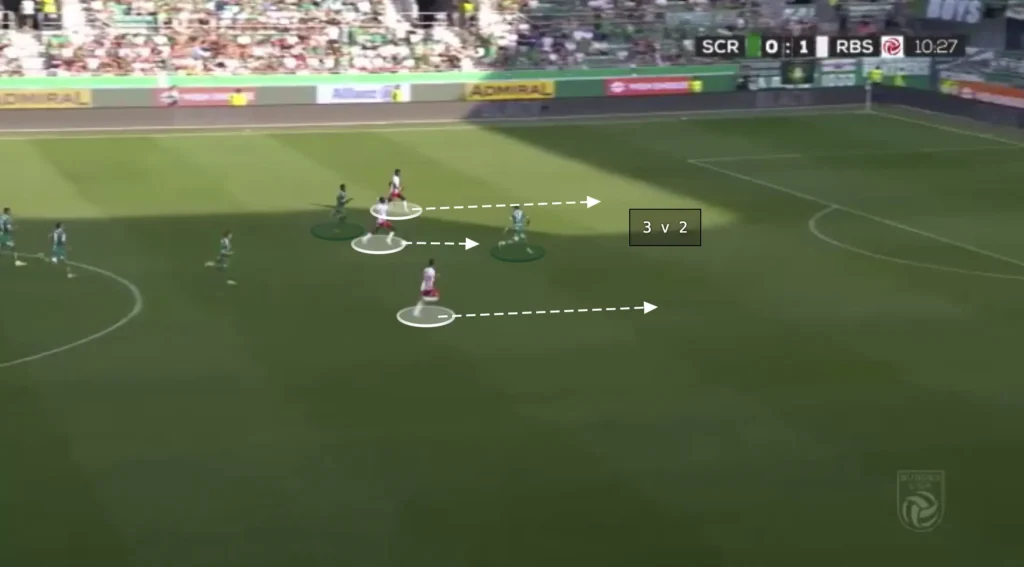
Final Thoughts
In conclusion, Pepijn Lijnders’ tactical approach at RB Salzburg emphasizes high-intensity pressing, fluid attacking play, and quick transitions, hallmarks of his football philosophy. His ability to implement an aggressive, dynamic style of play has transformed Salzburg into a team that thrives on collective energy and tactical intelligence. By using high pressing, overloads in key areas, and fluid formations, Lijnders has crafted a system that is both exciting and effective.
As Salzburg continues to develop under Lijnders, his tactical blueprint is set to create a foundation for sustained success. His approach not only maximizes the potential of individual players but also brings out the best in the team as a whole. The tactical analysis showcases how his strategies have the potential to make RB Salzburg a formidable force in modern football.
